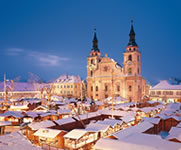
The North Sea is a shallow marginal sea of the Atlantic Ocean. It is around 100 metres deep and forms the western border of Schleswig-Holstein. The mere words call to mind fresh wind and weather, wonderful waves, amazing tides, mudflats, boat trips on the sea, water sports and holidays in one of Germany's most invigorating climates. Let your gaze roam across the flat fertile marshland, a unique landscape created by the sea between 4000 and 2000 BC. The ebb and flow of the tide are especially dramatic along the North Sea coast. Twice every day the sea level rises by two to three metres, flooding the mudflats along the coast. This is known as the incoming tide. After the water has reached its highest point (high tide), the tide turns and goes out again, just as it came in. The outgoing tide leaves large parts of the sea bed exposed, and when it reaches its lowest point, it is known as low tide. This is a region where the tides still influence the rhythm of people's lives.

The coast is lined by man-made dikes built to resist the power of the sea. Footpaths and cycle paths now run along the top of them as far as the white sandy beaches at St. Peter-Ording, the "world's biggest sandpit". The green dikes, which help protect the coastline and are grazed by woolly white sheep almost all year round, are backed by fertile marshland. Lying just off the North Sea coast is a series of small Hallig islands with seal banks, the only ones of their kind anywhere in the world. The Schleswig-Holstein Wattenmeer national park and biosphere reserve is another highlight. The mudflats are teeming with marine life: innumerable fish, crabs, worms and snails. For many migratory birds, it serves as luxury hotel, three-star restaurant, nursery and rest stop all rolled into one. When the water has retreated, there is a wonderful opportunity to walk on the sea bed and enjoy a mudflat walk – barefoot, of course. But, like anything exciting, the mudflats can be hazardous. Even on a perfect summer's day, the tide can come rushing in much faster than you imagine, or a thick, impenetrable fog can suddenly descend. Because of these very real dangers, never set out on a walk across the mudflats without an experienced guide.







